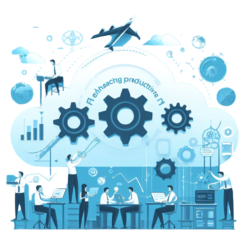Key Components of Employee Satisfaction

Work Environment
A positive work environment, characterized by open communication, respect, and inclusivity, is foundational to employee satisfaction. Employees who feel valued and supported in their workplace tend to be more satisfied.

Recognition and Rewards
Acknowledgment of employees' contributions and the provision of appropriate rewards and recognition play a vital role in job satisfaction. Recognized employees feel that their efforts are valued and appreciated.

Job Security
Providing employees with a sense of job security is a critical element of enhancing employee satisfaction. When employees feel confident about the stability of their positions.

Work-Life Harmony
Achieving a harmonious balance between work and personal life is crucial for employee satisfaction. Organizations that champion this equilibrium empower their workforce to adeptly navigate their personal and professional responsibilities, resulting in decreased stress.

Fair Compensation
Employees have a rightful expectation of receiving fair compensation for their contributions and efforts. Competitive salaries and benefits packages contribute significantly to satisfaction levels.

Career and Skill Advancement Opportunities
Providing avenues for career growth and skill improvement is a cornerstone of job satisfaction. When employees perceive a clear route for growth within the organization, they are more likely to find fulfilment in their current positions.

Effective Leadership
Strong leadership and management practices are essential for employee satisfaction. Leaders who provide guidance, support, and clear expectations foster a positive work atmosphere.
Why is employee satisfaction so important?
Certainly! Job satisfaction can be measured using various questionnaires and surveys. These tools help assess how happy employees are with their jobs. Here are some commonly used ones:

1.Enhancing Productivity and Performance
Employee satisfaction significantly contributes to elevating productivity and overall job performance. Contented employees are driven to dedicate their time and energy to their tasks, leading to heightened efficiency, improved work quality, and a favourable effect on the organization's overall performance.

2. Retention and Talent Attraction
High employee satisfaction levels reduce turnover rates and make it easier to attract top talent. Organizations that make employee happiness a priority are perceived as attractive employers, resulting in sustained employee retention and a competitive advantage in the job market.

3. Cultivating Workplace Culture and Engagement
A contented workforce cultivates a positive workplace culture and nurtures a feeling of belonging and engagement. This fosters a harmonious and cooperative atmosphere where employees are passionate about their positions and dedicated to accomplishing the organization's objectives.

4. Cost Savings and Competitive Advantage
Investing in employee satisfaction yields cost savings in the form of reduced recruitment and training expenses. Moreover, organizations that prioritize employee well-being gain a competitive advantage by outperforming their peers, attracting and retaining the best talent, and establishing themselves as industry leaders.
Employee Satisfaction Possible with Employee Monitoring Software
Employee satisfaction is a pivotal element in workforce management, with direct implications for productivity, employee retention, and overall organizational prosperity. To effectively boost employee satisfaction, organizations require tools and insights that can offer a comprehensive insight into employee behaviour and sentiments.
1. Behavioural Insights: Employee monitoring software tracks various aspects of employee behaviour in the workplace. This involves examining how employees allocate their work hours, the software applications and websites they utilize, and their communication patterns. By dissecting this data, organizations can acquire valuable insights into how employees interact with their assignments and colleagues.
2. Identifying Pain Points: Through continuous monitoring, the software can identify pain points in the work environment. It can detect areas where employees may be experiencing challenges or frustrations. For instance, if employees are frequently switching between multiple applications or dealing with excessive interruptions, it may indicate workflow inefficiencies that need attention.
3. Employee Sentiment Analysis: Some advanced employee monitoring software solutions incorporate sentiment analysis features. These features analyze digital communication, such as emails and chat messages, to gauge employee sentiment. By identifying positive or negative sentiments, organizations can understand how employees feel about their work environment, colleagues, and tasks.
4. Enhancing Communication: Effective communication is a cornerstone of employee satisfaction. Employee monitoring software can help organizations assess the quality of internal communication. It has the capability to identify communication bottlenecks, delays in response times, or instances of miscommunication. Equipped with this information, organizations can initiate measures to enhance communication channels and streamline processes.
5. Workload Assessment: An excessive workload can negatively impact employee satisfaction. Employee monitoring software can help organizations assess the workload of individual employees and teams. It can track the volume and complexity of tasks assigned and completed. If the data suggests an uneven distribution of work or frequent overtime, organizations can take corrective action to balance workloads.
6. Recognition and Rewards: Employee monitoring software can also assist in recognizing and rewarding outstanding performance. By tracking completed tasks, projects, and accomplishments, organizations can identify employees who consistently excel. This data can be used to implement recognition programs or provide performance-based rewards, increasing overall job satisfaction.
7. Feedback and Improvement: Employee monitoring software can facilitate continuous feedback loops. It enables managers to offer prompt feedback to employees using real-time performance data. Constructive feedback plays a vital role in assisting employees in enhancing their performance and fostering greater engagement in their work.
8. Compliance and Employee Privacy: It's essential to mention that while monitoring software provides valuable insights, it must be implemented with a focus on employee privacy and compliance with relevant regulations. Respecting employees' privacy rights ensures that the use of monitoring software is seen as a tool for improvement rather than surveillance.
In conclusion, employee monitoring software can be a powerful ally in measuring and improving employee satisfaction. By providing valuable insights into employee behavior and sentiment, it enables organizations to identify areas for improvement, enhance communication, recognize outstanding performance, and create a more satisfying work environment. When implemented thoughtfully and transparently, this technology can lead to a happier and more engaged workforce, driving overall organizational success.
The Link Between Employee Satisfaction and Employee Sanctification:
Employee sanctification takes the concept of employee satisfaction to a deeper level. While satisfaction focuses on the tangible aspects of the workplace, sanctification encompasses the idea of holiness or sacredness in the employee's perception of their work. It's about employees finding meaning, purpose, and fulfilment in their roles beyond just being satisfied with their jobs. When employees attain a state of sanctification, they go beyond mere contentment with their work; it transforms into a sense of calling and dedication. Their work transcends being just a job; it evolves into a vocation. They approach their tasks with a profound sense of purpose and unwavering commitment that extends beyond the material aspects of employment. Employee sanctification frequently results in elevated levels of engagement, loyalty, and enduring dedication to an organization. It harmonizes closely with an employee's values and convictions, forging a deep and meaningful connection between the individual and their work.In conclusion, employee satisfaction forms the foundation for the broader concept of employee sanctification. When employees find satisfaction in their work environment, receive recognition, and have access to growth opportunities, they are more likely to discover sanctification in their roles. This sense of sanctification can lead to heightened commitment, increased productivity, and a profound sense of fulfilment, benefiting both employees and their organizations.